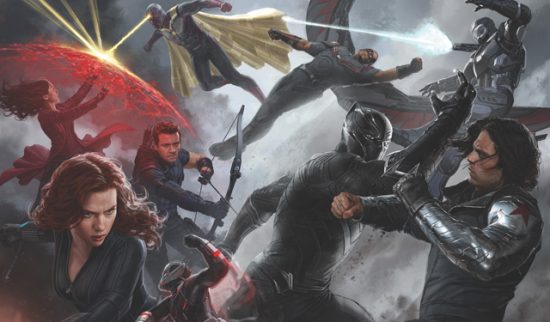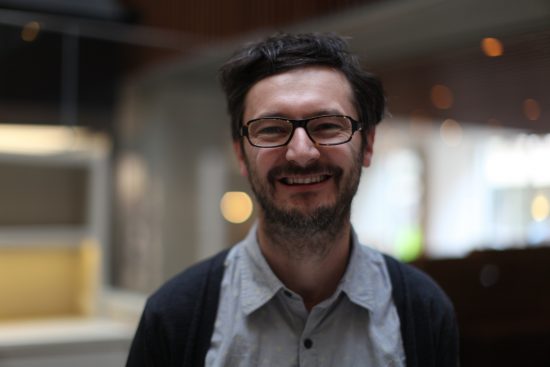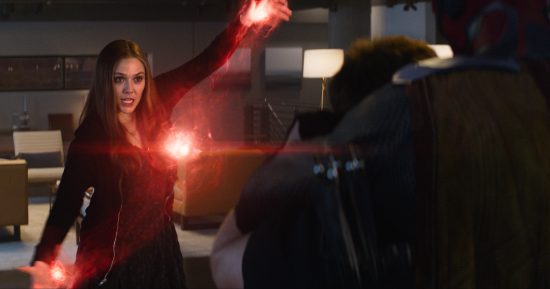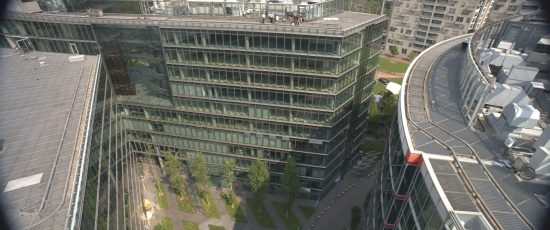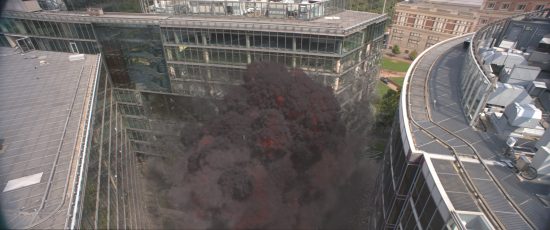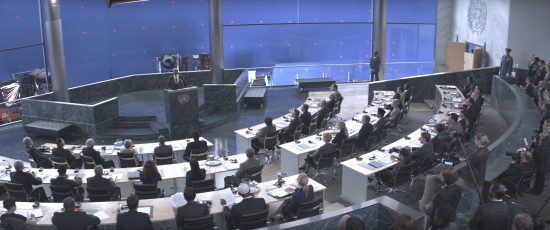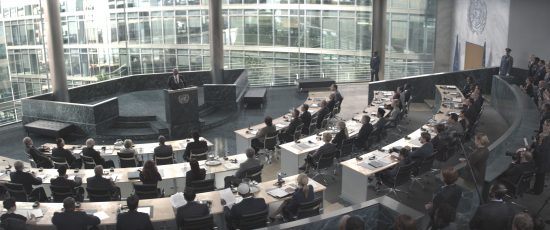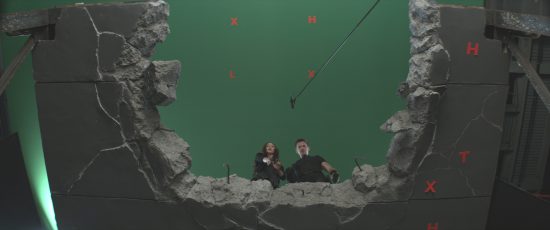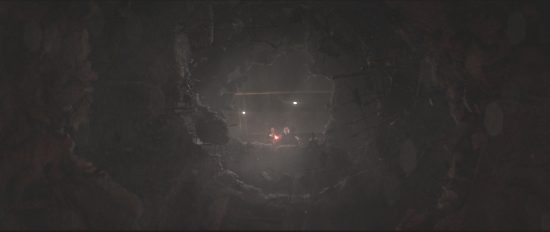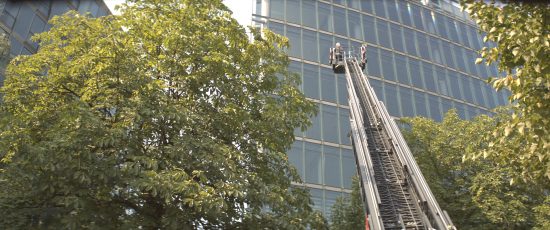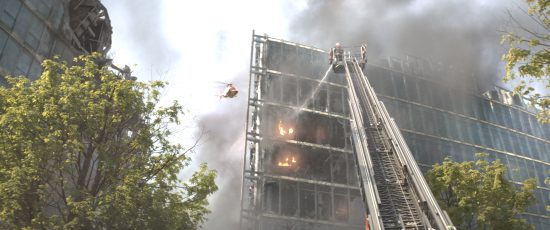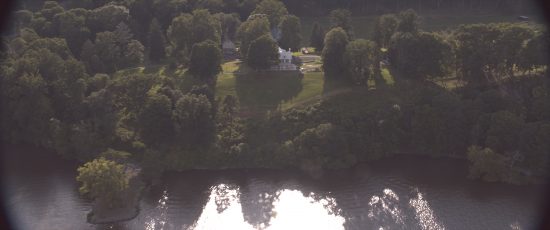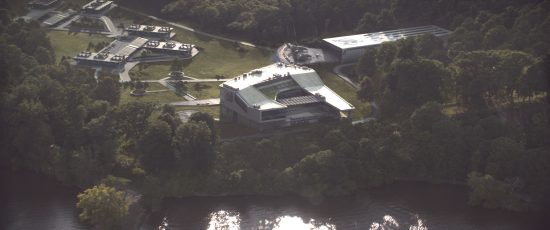Not Being Phased: Double Negative & Captain America: Civil War
Trevor Hogg looks back at the visuals effects created for Captain America: Civil War by speaking to Double Negative about Vision and destroying UN headquarters…
Four and a half months of work on Captain America: Civil War did not allow for much breathing room for Double Negative Visual Effects Supervisor Pete Jopling. “We came to the party late in November, picked up a couple of big sequences and sprinted from that moment onwards.” It was an enjoyable experience collaborating with Marvel Visual Effects Supervisor Dan DeLeeuw. You can tell that Dan has a great passion for the work and the enthusiasm palatable; he is all about story as with Marvel in general.” Despite the presence of previs there was still some extensive look development required for visualizing the ability of Vision to phase and become dense as well as his internal body structure. “The effects and concept guys were working closely together and were creating some cool looks. When we gave them this brief that said, ‘He is from another dimension. We want it to be something that you can quite put your finger on. It isn’t mechanical or organic but fits somewhere between the two.”
A celestial anomaly was used as a starting point. “The Aurora Borealis has some interesting shapes and structure to it,” notes Pete Jopling. “They asked if we could extrude the panel lines of his suit inwards. It was difficult not to make it not look like a big mess. We had to create enough definition to make it register that the panel lines were extruding into his body but without it becoming overly complicated.” A simplistic approach was adopted. “We introduced some interesting effects which resembled the filaments of a bulb that were like a neurological network. It had this sense of light travelling up and down them which hinted at something cognitive. We used that in conjunction with the Aurora Borealis but at the end of the day the filaments became much more present.”
“When anyone intersects with Vision their form becomes a burning yellowy green edge like when he goes through a wall in the comic books,” remarks Pete Jopling. “We also wanted to have some of his filaments get disturbed by objects passing through him. That was something we had to do in effects in order to get that interactivity so that it would give us the sense that Hawkeye and him were in this duel together.” Despite the odds being stacked against him, the proficient archer is momentarily able to contain the otherworldly being. “Hawkeye never fired any arrows for real so we had to generate a number of CG ones. He fires them into the wall which generates this electrical cage with a Tesla lighting effect that traps Vision. The idea was that ability of Vision to control his body would be affected by this electrical cage and would fluctuate. He is slightly phased and is in some degree of discomfort. These electrical Tesla effects would hit and travel up his surface but would also be going into his body. We would see them hitting the back surfaces of his body and it bounces around so you get this frizzling electricity bouncing around his internal structure while he is being held by the cage.”
“I didn’t realize that the phasing effect would rely so much on compositing,” reveals Pete Jopling. “We had a big challenge trying to depict in a clear way his front and back surface and came up with a somewhat accidental fix in compositing. It was always meant to be a plate holder but it became so simple but so effective that it stayed and did the job. We used his suit texture displacement to drive a certain distortion so when his body goes transparent his suit goes transparent. It would be clunky to have it fade off so we introduced this displacement effect that went like a refraction to still represent the texture of his suit but made it transparent at the same time. It was a much nicer way to reveal his internal structure.”
“There was ever only going to be one winner but fortunately Hawkeye has some assistance in the end to help him out,” notes Pete Jopling. “How much of Wanda’s magic was going to be influencing Vision, what would he look like, and at what point in the sequence was not fully resolved by the studio. It’s quite a complex thing to tell and communicate to the audience in just a few shots when she takes control of the faculties of Vision and forces his density off the scale. There is little dialogue so it all had to be done visually. It was an incredibly hard shot to imagine having somebody’s body being slammed through the floor and into the earth. It was a tough section to pull off. Once Vision goes through the floor it becomes a fully digital world. The shots can be whatever you want them to be in terms of telling the story. They had to look real but it’s in an unreal thing to try to do. We started those shots straightaway and they were the last ones to be delivered.”
“Wanda’s magic is constantly evolving shot-to-shot and then there’s every environment and situation that she uses it which requires a slightly different approach,” observes Pete Jopling. “We created a neutron star in her hand, and the gravitational effect and interactive light came from that. How dense is it? How hot is it? Where’s the falloff? It’s a big crackly core which was fine for wide shots but when you were close-up the wiggly woo didn’t look so interesting. We had to put in more detail to make it look like a hot core.” The character had to appear as if she had the ability to create a pocket dimension. “In the palms of her hands we developed tiny cores of energy. From the cores of energy these streams of particles, like very fine tendrils, collided in front of her and would turbinate to generate this hot core matter which is driving her ability to control Vision’s density and phasing.”
“The explosion and smoke for United Nations headquarters in Vienna were somewhat easier and harder,” states Pete Jopling. “Can you make an explosion go off in full daylight in the middle of a courtyard and give that a sense of scale and photo-reality it needs? With Wanda’s magic we were trying to hit a moving target while the explosion was not so much a creative but at technical thing.” The original green screen plan had to be modified. “The outside environment ended being a fully CG asset as we were never going to be able to project the photography that was provided as all of the baked in reflections no longer made any sense. It enabled us to show to Dan and Swen Gillberg [Second Unit VFX Supervisor] what exactly that would look like on any floor because when they shot the photography there were on a scissor lift which could only get so high. We went up three floors and you could see inside where the conference was taking place and all of the curved desks. When we cut to the inside we could actually show the true height from that building with all of the proper reflections which paid dividends as it was so much easier for us to map out the sequence to show Dan.”
“The wide hero shot inside was difficult,” states Pete Jopling. “We were slightly misled at first because we didn’t realize that they were on the third floor for any particular reason. We took all of the lens information from the green screen stage camera and applied that focal length to our CG background so we would know that was technically correct at the height of the floor that we were on.” Practical elements were incorporated. On-set for the blue screen auditorium they set a pyrotechnic inside the podium and had this amazing explosion shot at a high speed to show all of this beautiful immaculate smoke and debris flying towards the camera. There was big rolling ball of dust which in the trailer shot another vendor used quite extensively but when it came for us to do the shot they wanted the explosion to going from screen left to right to mimic the position of the explosion outside and to also make it more dynamic. We couldn’t use any of it in the end.”
“The shards of glass streaming across the frame were a powerful and explosive element that we wanted to use to give that sense of danger across these shots,” remarks Pete Jopling. “It was a difficult thing to get quite right because we rendered a simulation with an enormous amount of detail. We broke these huge panes of glass that exploded inwards. It created a huge amount of distortion to the background image. We had to render those out as separate passes because to try to do it in all one go was too difficult and became unwieldy. We rendered out thousands upon thousands of shards of glass that do refract the environment that we created so you do get those kinds of colour qualities coming through all of those shards of glass as they stream into the room. They land on the desks. There’s a glitter of glass landing on the desks and on the ground and all around the auditorium.”
“We had a pyroclastic quality in the initial explosion which had this internal illumination, it evolves into a dense ball of cloud and then some secondary thinner smoke comes,” states Pete Jopling. “It’s playing to the idea of a different material from the detonator is burning that is giving you that kind of variation. You don’t want it to look like a burning oil field but it needs to represent something dangerous, thick and explosive.” Some cinematic modifications were needed. “A 3D asset was built for the destruction with all of the window frames and floors. Our initial simulation pretty much toasted the building. We had pancaking floors and the front façade completely slid away. When we showed that to Dan and Swen they went, ‘Whoa! Everyone’s dead if you do that. You can’t go that far!’ We would wound back the level of destruction to being more localized so the structural integrity wasn’t so compromised. The digital doubles in there are either crawling around or still seated. We still needed to be able to look inside to see T’Chalia who becomes the Black Panther.”
“Post-destruction scenes were literally blue screen behind some open window frames and some masonry was dressed in with upturned chairs and rubble,” remarks Pete Jopling. “We dressed in loads of buildings back there with all of the ambient smoke spilling out everywhere, debris raining down, dust, and little fires. We built up dense layers of dust and debris. We had this element of falling and burning sheets of paper. Bits of window frames were falling from the stories above. It became an aesthetically pleasing shot.” Creative interpretation was required. “You don’t get footage of actually being inside a building when an explosion goes off. Even if you did it would be over in two frames and be completely embedded in dust and debris. You have to break it down. These story beats of the explosion going off outside, the glass shattering, the window frames caving in, and all of this debris coming into the building and raining down onto the desks. Otherwise it becomes confusing, is over too fast and isn’t aesthetically pleasing. You want to stretch out the moment.” The surrounding vegetation was not completely cooperative. “We had some trees in the foreground that were unaffected by the explosion and bothered me forever. Then suddenly we came up with a way of bending them which was a nice touch.”
“Daytime aerial shots of the Avengers compound which was part of our sequence,” remarks Pete Jopling. “It’s quite a big establishing shot. We had a plate which was great. We had to do a layout for the compound and worked on all of the assets to make sure that they held up at that distance. There wasn’t the time to look development the whole compound. We did a lot project and compositing tricks in Nuke to get it to look good quickly.” Houdini was used primarily for effects and to get photo-realistic results the destruction was rendered by Clarisse. “I’m really please that there’s this big hero moment when Wanda forces Vision to phase and he drops Hawkeye. All of our look development is all on display there and that’s the shot which is a culmination of a lot of people’s efforts.”
Imagery courtesy of Disney, Marvel Studios and Double Negative.
Many thanks to Pete Jopling for taking the time to be interviewed and for more information visit the official website for Double Negative.
Trevor Hogg is a freelance video editor and writer who currently resides in Canada; he can be found at LinkedIn.

